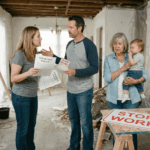But soon, tiny homes became more than a countercultural experiment. They became a financial survival strategy. Tens of thousands of Kiwis, especially women aged 45 and older, separated adults, retirees, and single-income earners, found that a small, well-built home could provide a dignified life without massive debt.
In many cases, it was the only viable pathway to housing stability. Yet once again, the ground beneath the movement is shifting. Granny flat reforms, set to take effect nationally in early 2026, are about to change everything. And while the legislation hasn’t officially rolled out, it’s already reshaping the industry.
Tiny living is on the cusp of its next evolution, and it’s one that will split the movement in two.
The earliest tiny house owners did everything they could to fly under the radar. Most homes were built on trailers, not because people wanted to move them, but because that was the only way to avoid triggering full building consent processes, which makes no sense when you don’t own the land. On paper, they were vehicles. In practice, they were homes, parked semi-permanently on rural land, tucked into family properties, or leased on quiet back sections. But with that workaround came risk.
No formal recognition as a dwelling meant: No access to standard “home loan” bank loans. Limited insurance options. And no guarantee the council wouldn’t ask you to move it. The tiny house lifestyle worked, but it required courage, compromise, and often, legal limbo.
Starting in 2026, councils around New Zealand will be required to allow a second dwelling, up to 70 square metres, on most residential and rural zoned properties that are allowed second dwellings on them without the need for a building consent. This opens the door for what were once seen as “granny flats” to become mainstream secondary dwellings.
But the real significance lies beneath the policy language. For the first time, people who own land and already have an existing dwelling on it will be able to build a single level, legally recognised small house without expensive, drawn-out building consent processes. In short, people will no longer need wheels to live in a tiny home. And that changes everything.
You’d expect a change like this to spark momentum after it’s implemented. But the market’s not waiting. Already, tiny home builders and consultants are reporting a clear pattern. Clients are pausing trailer-based builds, choosing to wait until the new rules come into force. For many, the cost of building now without financing or consent certainty just doesn’t stack up when a better option is around the corner. And the industry is responding.
Builders are actively pivoting, shifting their focus from wheeled units to fixed-foundation granny flat-style homes that align with the 70m² guidelines. Design templates are being redrawn, brochures updated and marketing strategies rewritten. This isn’t a hypothetical reform. It’s already reshaping the supply chain, the product offering, and the mindset of those looking to downsize, house loved ones, or invest in small-scale rental housing.
What this reform is creating, whether by design or by accident, is a visible split in the tiny house movement.
Two clear and distinct streams are now forming:
Firstly, “The Legalised Small Home Track For those with access to eligible land”, either their own, or shared family property and this is a game changer.
These people will build foundation-based, single level homes under 70m². They will use standard building materials and methods, have better access to home loans, more insurance options, avoid legal disputes, gain long-term housing security and a potential for passive income. These homes will be fixed in place and considered “real” houses in the eyes of the law and the banks.
Expect to see simple, single-storey designs optimised for this new opportunity, modular homes, transportables, and smart layouts that cater to older adults, intergenerational families, or rural landowners housing workers. This track is about stability, security, and mainstream adoption.
Secondly, The Mobile, Grey-Zone Tiny House Track but for those who don’t own land, and don’t have family willing or able to share, it will be a very different story.
They’ll remain on the path of building tiny homes on trailers, leasing land (often informally), relying on limited financing options or paying upfront and navigating inconsistent council enforcement too. Further, living with the ongoing risk of theft, eviction, or regulatory issues too.
This stream isn’t disappearing; it still serves a vital purpose, but its visibility and growth may slow as the legalised track becomes more dominant. Where once the movement was unified by its wheels, it’s now splitting into mobility by necessity vs permanence by opportunity. Let’s be honest, those who already have access to land will be the biggest beneficiaries.
They’ll build wealth. They’ll create housing options for family or tenants. They’ll gain equity in legally recognised homes, meanwhile, those still shut out of land ownership remain stuck in limbo. For them, tiny living remains a workaround, not a protected right and as banks, builders, and policymakers embrace the foundation-based granny flat model, there’s a risk that those still living on wheels become further marginalised, viewed as the “unregulated fringe” of an otherwise maturing industry.
We’re heading toward a future where the term “tiny house” may no longer mean a home on wheels. Say it in five years, and someone may picture a clean lined, 70m² build tucked behind a family home, complete with double glazing, a bank mortgage, and a linen cupboard. The wheeled tiny house won’t vanish, but again it may no longer be the public face of the movement.
Instead, it becomes a subculture within a broader shift toward small, smart, and legal. This moment, quiet as it might seem, is the pivot point of the tiny house movement in New Zealand. The reform opens the gates to a whole new type of small living, grounded, financeable and secure. But only for those who can walk through them. Tiny house designs are evolving, priorities are diverging, and a quiet divide is taking shape. That divide isn’t the end of the movement; it’s the clue to where it’s heading next.
The future of tiny living in New Zealand will be defined not by a single path, but by the choices made in this moment of change by those who will choose to build theirs or keep it on wheels, however way it is for you, consider the risks and issues ahead of time to futureproof your home or rental.
At this stage it seems wiser to rather use that money as a deposit to build one than pay the deposit to buy one, of course dependant on obtaining a bank loan and the land, or considering keeping the deposit until it is in fact more to choose the “off-wheels” option.
If the deposit is however enough to buy a decent “on-wheels” Tiny Home, it should cover the cost of building an “off-wheels” too, then it is only a matter of obtaining the land.
Going rural could cost you much less and perhaps there could be a possibility to do a rent-to-own land option. This type of agreement could be challenging and comes with risks, but where there is a will, there is a way!





